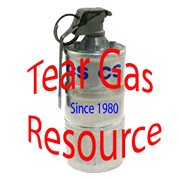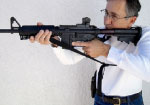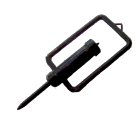Decontaminating a structure after the use of non-lethal chemical agents is an often an over looked procedure. Most tactical units arrive, see the problem and conquer. More times than not, tear gas was used in the conquest. Left behind, after the operation, there may be broken doors, broken windows, dead bodies and chemical agent contamination. In most agencies the tired heroes now leave the scene.
 Cleaning up behind them is the last thing on their minds.
However, a few simple actions by them could save your agency a great deal of money in post operation civil claims. Some agencies such as the Sacramento California Police Department have recognized the liability problems attached to the use of the agents and have made moves to lessen them.
Cleaning up behind them is the last thing on their minds.
However, a few simple actions by them could save your agency a great deal of money in post operation civil claims. Some agencies such as the Sacramento California Police Department have recognized the liability problems attached to the use of the agents and have made moves to lessen them.
These actions are not what your SWAT deputies picture themselves doing. But they are the logical choice because they are on the scene and have the right equipment to perform immediate decontamination. If your agency has the resources, perhaps they can have a professional cleaning crew standing by to decontaminate the structure you just assaulted. Maybe you can find some extra people sitting around that can help. Firemen usually have some equipment necessary to begin decontamination. It might be that your agency just ignores the problem and lets the insurance carrier handle it. This certainly is the most prevalent approach. (see prior article on decontamination liability)
Each type of non-lethal chemical agent has its own unique cleanup process. Some chemicals can be neutralized and some not. The most common chemicals now being used in law enforcement are Cn (Chloracetophenone), CS (Orthochlorbenzalmalononitrile) and OC (tincture of oleoresin capsicum). The saturation accomplished by the use of the tear gas varies with the type of carrying agent used. When powder (blast dispersion) or liquid (ferret rounds) tear gas is used they fall from the air faster than when smoke is used as a carrier.
Measurements after the initial use of these different types of agents showed that smoke as a carrier kept more agent in the air. When smoke is used as a carrier the initial use should produce about 12 parts per million of the agent in the air. The initial use of agent in powder form is .25 parts per million and with liquid .48 parts per million. As a comparison, the California Occupational Health and Safety Agency (Cal-OHSA) standard states that uncontaminated air shall have a permissible limit of .050 parts per million of CS. This standard can be found in the California Code of Regulations, Title 8 Section 5155. Although complete decontamination is very difficult at best, there are several things we can do to facilitate it.
The first procedure is to aerate the structure by opening as many  windows as possible. Try and blow out any particles still airborne. If possible cloth covered furniture and clothing should be removed to an area where uncontaminated air can blow particles of agent off and out of them. Large fans can be placed on the upwind side of the structure to blow the agent out.
This has proven to more efficient than sucking the agent by placing fans on the downwind side and trying to suck the particles out. The wind created by the fans on the upwind side will help get some of the settled particles airborne again. If you have the luxury of enough fans place them on both sides of the structure; the upwind fan blowing in and the downwind fan sucking out.
The warmer the day is will relate directly to the amount of agent that will stay airborne. Airborne agent will exhaust where settled agent will not. A little heat will go a long way.
Pick-up and take with you any ordinance expended. Don't leave anything behind that an innocent person may pick up and injure themselves with. This will also prevent further contamination of the structure if your ordinance didn't totally expend its load upon deployment.
windows as possible. Try and blow out any particles still airborne. If possible cloth covered furniture and clothing should be removed to an area where uncontaminated air can blow particles of agent off and out of them. Large fans can be placed on the upwind side of the structure to blow the agent out.
This has proven to more efficient than sucking the agent by placing fans on the downwind side and trying to suck the particles out. The wind created by the fans on the upwind side will help get some of the settled particles airborne again. If you have the luxury of enough fans place them on both sides of the structure; the upwind fan blowing in and the downwind fan sucking out.
The warmer the day is will relate directly to the amount of agent that will stay airborne. Airborne agent will exhaust where settled agent will not. A little heat will go a long way.
Pick-up and take with you any ordinance expended. Don't leave anything behind that an innocent person may pick up and injure themselves with. This will also prevent further contamination of the structure if your ordinance didn't totally expend its load upon deployment.
CN - When using CN as your agent of choice, many times aeration and vacuuming is the only thing needed for decontamination. The first step in decontamination of CN is aeration. The sooner you start aeration the better it will be. If you wait an hour or more little will be gained by aeration alone. Because of the relatively low melting point of CN, heating a contaminated room will allow for the settled agent. If you now close all the doors and windows except one at either end of the building it will help ventilate the building. Place a fan at one end of the building and heat the interior as much as practical. The hotter you can get the building the more agent you will be able to remove using this method. Everything that has been exposed should be vacuumed with a wet/dry vacuum using a hepa filter.
 Surfaces that won't be harmed can be washed with a five percent solution of washing soda (sodium carbonate Na2CO3) and water. This mixture will help decompose the CN. If washing soda is not available five percent solution of baking soda (sodium bicarbonate NaHCO3) and water can be used.
This will also help break down the chemical. However, it works more slowly than washing soda. This solution may harm some surfaces. The solution can be used in a wet and dry vacuum for rugs and other cloth surfaces. Drapes, curtains, etc. should be dry cleaned.
Surfaces that won't be harmed can be washed with a five percent solution of washing soda (sodium carbonate Na2CO3) and water. This mixture will help decompose the CN. If washing soda is not available five percent solution of baking soda (sodium bicarbonate NaHCO3) and water can be used.
This will also help break down the chemical. However, it works more slowly than washing soda. This solution may harm some surfaces. The solution can be used in a wet and dry vacuum for rugs and other cloth surfaces. Drapes, curtains, etc. should be dry cleaned.
CS - The first step in decontamination of a structure contaminated with CS is aeration. The object of which is to remove all airborne particles of chemical agent. Open all doors and windows and attempt to create air flow through the structure. Fans should be used. The fire departments smoke ejector fans are ideal for this. The Sacramento California Police Department in their study dated August 23, 1988 recommend aeration to continue for one to two hours. This will obviously vary depending upon the amount of agent used.
The building should then be closed and heated as much as possible. This will help vaporize the remaining agent. This should be done for approximately one hour. After heating the structure open it back up and ventilate again. The second ventilation should be for approximately one hour or until the exhausted air has no more contaminates in it. The sooner aeration is started after deployment the more effective it will be.
Hard non-absorbent surfaces (I.E. floors, enamel painted walls,  cabinets, etc) can be washed with a chemical solution that will help dissolve the contaminants. The solution should contain ten percent MEA (Monoethanolamine) and six tenths of a percent of Triton X-100 or Igepal C-630 and distilled water (no chlorine). If the MEA or the Triton X-100 is not available substitute Tide or Joy soap. If tap water is used double the amount, to 1.2 percent of Triton X-100. A properly mixed solution should consist of 6 2/3 pints of MEA with 55 pints of distilled water, and three ounces of Triton X-100.
cabinets, etc) can be washed with a chemical solution that will help dissolve the contaminants. The solution should contain ten percent MEA (Monoethanolamine) and six tenths of a percent of Triton X-100 or Igepal C-630 and distilled water (no chlorine). If the MEA or the Triton X-100 is not available substitute Tide or Joy soap. If tap water is used double the amount, to 1.2 percent of Triton X-100. A properly mixed solution should consist of 6 2/3 pints of MEA with 55 pints of distilled water, and three ounces of Triton X-100.
Food products packaged loosely should be discarded. Eating contaminated food will cause diarrhea. It tastes so bad that most people wouldn't be able to eat it anyway. Air tight packages can be opened after exterior cleaning. Cloth furniture, clothing, and other items which cannot be wiped or sprayed and rinsed will have to be removed from the structure. They can be dry cleaned or steam cleaned with the MEA solution. Clothes should be washed in a solution using Tide or Joy soap. The solution can be applied with a sprayer, mop, brush or towel to the contaminated surfaces. It should remain on the surface for approximately ten minutes. The surfaces can then be rinsed with tap water. The rinse water should be removed with a wet vacuum to avoid the effluent from contaminating other areas. The effluent should be a harmless by-product. If the structure has a central heating and/or cooling unit shutting it down should be considered. If it re-circulates, the inside air contaminate will get into the filters of the system requiring the system to becleaned out. Use portable heaters to heat structures whenever possible.
Several commercial products are on the market that claim they can be used as a decontaminating agent. These are both referred to as a tear gas neutralizing agent. Tests conducted have found that theses gas neutralizing agents are very slow to counter the chemical. The active chemical in these neutralizers encapsulate the chemical crystals rendering the chemical inert. The manufacturer advertises that the product can be applied directly to the human skin and mucous membranes safely. The two commercial names are TF-90 and GNA-1.
SOME DECONTAMINATION CHEMICAL MANUFACTURERS Monoethanolamine (MEA) Dow Chemicals 1-800-258-2436 - Triton X-100 Ashland Chemical Distribution Center Roanoke, Virginia (703) 981-1255 - Igepal CO-630 Ashland Chemical Company Colombus, Ohio (614) 889-3333 - TF-90 Suchan Enterprise Anaheim, California (714) 952-3402 - GNA-1 Security Support Services Washington, D.C. (202) 546-6300
Several other areas of decontamination that we should concern ourselves with are; personal (skin), and outdoors.





